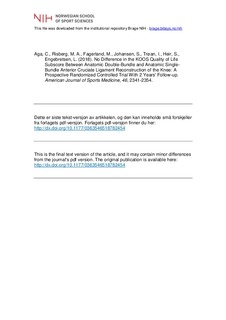No Difference in the KOOS Quality of Life Subscore Between Anatomic Double-Bundle and Anatomic Single-Bundle Anterior Cruciate Ligament Reconstruction of the Knee: A Prospective Randomized Controlled Trial With 2 Years’ Follow-up
Aga, Cathrine; Risberg, May Arna; Fagerland, Morten; Johansen, Steinar; Trøan, Ingrid; Heir, Stig; Engebretsen, Lars
Journal article, Peer reviewed
Accepted version
Permanent lenke
http://hdl.handle.net/11250/2570684Utgivelsesdato
2018Metadata
Vis full innførselSamlinger
- Artikler / Articles [2119]
Sammendrag
Background: The double-bundle reconstruction technique was developed to resemble the properties of the native anterior cruciate ligament (ACL) more closely than the conventional single-bundle technique. The clinical benefit of the operative procedure is controversial, and there is a need for studies with a focus on patient-reported outcomes (PROs). Study Design: Randomized controlled trial; Level of evidence, 1. Hypothesis: Anatomic double-bundle ACL reconstruction would be superior to anatomic single-bundle reconstruction regarding the change in the Knee injury and Osteoarthritis Outcome Score (KOOS) Quality of Life (QoL) subscore from baseline to 2-year follow-up. Methods: According to sample size calculations, 120 patients aged 18 to 40 years with a primary ACL injury of their knee were randomized to the anatomic double-bundle or anatomic single-bundle reconstruction groups. Patients with posterior cruciate ligament, posterolateral corner, or lateral collateral ligament injuries or with established osteoarthritis were excluded. Patients with residual laxity from a coexistent medial collateral ligament injury were excluded. Data were registered at baseline, 1 year, and 2 years. In 24 patients, postoperative 3-dimensional computed tomography was performed to verify the positioning of the bundles. The outcome measures were the change in KOOS subscores and the International Knee Documentation Committee 2000 subjective score, pivot-shift test result, Lachman test finding, KT-1000 arthrometer measurement, activity level, return-to-sports rate, and osteoarthritic changes on radiographs. A linear mixed model was used for the analysis of all the PROs, including the primary outcome. Results: The change in the KOOS QoL subscore from baseline to 2-year follow-up was not different between the double- and single-bundle groups (mean change, 29.2 points vs 28.7 points, respectively; –0.5-point difference; 95% CI, –8.4 to 7.4 points; P = .91). Neither were there any differences between the 2 groups in the remaining PROs, knee laxity measurements, or activity levels of the patients. Radiological signs of osteoarthritis were found in 2 patients. Eleven patients had a graft rupture: 8 in the single-bundle group and 3 in the double-bundle group (P = .16). Three-dimensional computed tomography of the knees verified the positioning of the anteromedial bundle, posterolateral bundle, and single-bundle grafts to be within acceptable limits. Conclusion: There was no difference in the KOOS QoL subscore, the remaining PROs, knee laxity measurements, or activity levels comparing the double- and single-bundle ACL reconstruction techniques. The number of bundles does not seem to influence clinical and subjective outcomes, as long as the tunnels are adequately positioned.
Beskrivelse
I Brage finner du siste tekst-versjon av artikkelen, og den kan inneholde ubetydelige forskjeller fra forlagets pdf-versjon. Forlagets pdf-versjon finner du på journals.sagepub.com / In Brage you'll find the final text version of the article, and it may contain insignificant differences from the journal's pdf version. The definitive version is available at journals.sagepub.com
